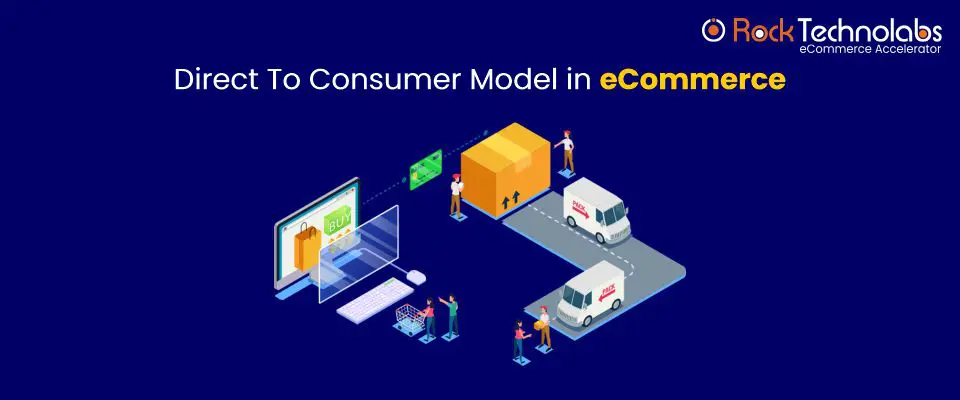Everything You Need to Know about D2C Commerce
The Direct-to-Consumer (D2C) is one of the fastest-growing popular routes for manufacturers and CPG (Consumer Packaged Goods) brands to enter the market directly rather than through a middle-man. It is a perfect model to “cut out” the middleman participation. A study shows that 55% of consumers favour shopping directly from the brand manufacturer instead of retailers. Hence, having a strong D2C e-commerce strategy gives manufacturers full control of all their activities, from packaging to marketing.
This helps in the growth of businesses focused on manufacturing independently, promoting and selling their products. The popularity of this strategy has changed the whole structure of the company because it makes the entire merchandise easier.
The D2C marketing strategy is steadily improving. It has become the most popular choice of manufacturers and Consumer Packaged Goods (CPG) brands to stop involving mediators in the whole production and sale process because it has become a lot easier.
D2C removes the mediocre between the producer and the consumer, thus allowing them to have improved control over production and sales. The producer can engage directly with ultimate consumers and learn the outline on what are the needs of consumers. Thus, D2C has numerous advantages, challenges and engagement with consumers. Let’s check out the detailed description of all these in this blog.
The expectations of customers are changing with preferences for streamlined experiences and good convenience. Therefore, brands that motivate direct consumer marketing keep on stressing marketing techniques to attract more consumers. This innovative method also launched more scope for brands and marketing teams to sell the products on a stream that is known to everyone.

Every concept has its pros and cons with challenges. Nothing is complete without some advantages and disadvantages. Before initiating any strategy, the retailers must be accustomed to what is good and beneficial for them and what points may lead to concerns.
There are some questions that the retailers should ask themselves before implementing D2C commerce like:
- ● Can you conduct market research before selling products directly to customers?
- ● Is it possible to segregate customers based on demographics, age or other factors?
- ● How can you target each segment?
Some of these questions should be considered before starting D2C commerce, as the answers will ease your whole journey in developing strategies.
Let’s move on to some of the challenges of D2C eCommerce
-
1. Choosing the right product to sell
Businesses offer several products to their customers according to demand and supply. Still, when it comes to D2C, you should have an effective and detailed marketing strategy to analyze the competition rate and help you grow. Deciding which products to sell through e-commerce stores can be tricky. In order to carry out this, you need to get in touch with an authentic fulfillment service provider that manages wholesale products and offers compliant product options for their customers.
This is one of the methods to meet customer demand and to ensure that inventory never gets out of stock.
-
2. Storing the product which is in demand
When you start receiving bulk orders from customers, you are required to make provisions that you have adequate stock of inventory. You need to find a method to capitalize customer orders and search for options to fulfil the customer’s requirements. If you’ve never focused on scaling inventory, storage and rising product demand, then this may impact your business. It may lead to a situation where you cannot meet order demand and lose valuable revenue resources. However, order fulfilment providers have the resources and expertise to manage the changing needs. Hence, it can provide the warehouse space, staff, and resources to complete customer orders without delay.
-
3. How to manage the returns?
As per NRF research,$428 Billion in Merchandise Returned in 2020. Undoubtedly, returns are an indispensable part of online business. Therefore, an online business should have active systems to serve customers by offering hassle-free returns or replacing any damaged products. Providing easy returns is a critical part of any online business. Accurate processing of product returns will enable you to retain customers and even support in earning favourable reviews online.
-
4. Attractive packaging
Having a fantastic product is just halfway to D2C commerce. Because that’s not all you need, an attractive packaging that can allure customers to buy the product is what you need the most. It’s your sole responsibility to offer a memorable unboxing experience to customers, primarily if you sell subscription boxes. Excellent and quality packaging ensures that products reach customers in superb condition. Second of all, you need to make sure that the consumers accept your brand as a high value even before they check your product physically. To achieve this, focus on delivering appropriate packaging to customers but only in excellent condition. It reduces the chances of returns and replacements and, ultimately, improves your customer satisfaction.
Advantages of D2C eCommerce
You can have control over brand messaging and consumer engagement. But, How? Allow us to elaborate!
In D2C commerce, the manufacturer has complete control over the product outcome. Whereas the traditional manufacturer takes care of packaging and other marketing activities but fails at handling the sale part. That’s why, Manufacturers allot their money in promotion and advertising, but the final presentation of the product depends only on retailers. Hence, it is important to focus on retailers. Traditional manufacturer – retailer relationship offers less space for manufacturers.

-
1. More innovation opportunities
According to Avendus Capital’s latest report, the D2C is expected to be $100 billion by 2025. Marketing and sales is all about innovation. So if you employ effective, innovative techniques, that can help you gain an edge over the competitors. However, most retailers follow a set of standards while selling products. That’s why they often don’t sell new products to the market. Because of this, manufacturers experience manufacturing restrictions. But if you use D2C, manufacturers focus on new products, hence testing it with selected demographics to get feedback. By doing so, the manufacturers understand consumers’ needs to decide what to sell.
-
2. Direct access to customer
Learning more about consumer behavior permits manufacturers to upgrade existing products and develop new products. That’s why direct interaction with customers using different platforms of the buying process allows manufacturers to understand more about consumers. This includes post-sale methods such as collecting email addresses, location, social media profiles and purchasing preferences to offer detailed information about their product preferences and the product overview.
-
3. Improved margins
D2C marketing strategy enables brands to sell products at the same price as retailers. In this way, manufacturers earn higher profit margins by eliminating middlemen from the entire scenario. A middleman selling their products tends to only take advantage of the profit margin from cost to gross sale.
-
4. Stronger brand loyalty
Manufacturers offer better services to customers and support them with D2C strategy while being loyal to their brand.
There is improved self-determination from manufacturers while offering better services to customers and support with D2C.
-
5. Expanded market opportunities
Do you know manufacturers can freely sell globally without having any geographical restrictions? Chances are you had no idea about it until now. But it’s okay. Selling globally is the perfect opportunity to sell the products to the right consumers in the right market. According to statista, D2C online sales were projected to surpass 129 billion U.S. dollars in 2021.
To achieve this, you need to employ this D2C strategy essential from a financial and operational standpoint. There is no harm in being proactive and developing plans beforehand to ensure that the model fulfils consumers’ demands.
To get started with D2C, here is a 10 step guide that helps start with D2C commerce.
-
● Start thinking like an entrepreneur
First, explore what D2C is, its benefits, and feel empowered once you take things into your own hands. Then, start embracing critical questioning, innovative methods and continuous development. It enables you to create and develop your own D2C eCommerce business that can be exciting and highly rewarding.
-
● Think of it as a mission
Start making a blueprint of the whole development cycle on how things will move. You should have a purpose and get on a mission to unravel an actual critical problem for your potential customers. The gaps within the market allow manufacturers to develop successful D2C brands.
-
● Try to estimate the chances of success.
It would help if you had a deep analysis of your customers, competitors and the market to avoid a rough and bumpy journey. For example, you can start understanding the expectation of your customers from the product that you offer. This will raise your chances of success. In addition, your target demographics, shopping behaviors and buying decisions, market conditions, competitive analysis and insights during market research can help make your decisions more effective and more substantial.
-
● Connect your audience while standing out in the crowd.
Try to be unique in ideas and communicate the same to your audience. Start creating a good branding exercise through the d2c eCommerce platform. Branding is the marketing practice that allows marketers to own their name, logo, design, and visual identity as good branding for a business model can connect with people emotionally. You can also use chatbot for ecommerce for providing them personalised services.
It benefits you because the customers know what D2C is and can identify your brand.
-
● Segregate the investments
Starting a D2C eCommerce brand website is easy and less expensive than a traditional business. However, several other costs are involved in this process:
a. Domain name: It is the name of your website/URL. The brand name of your eCommerce business should be part of the URL.
b. Costs for SaaS eCommerce Platforms: There are numerous competing platforms for setting your D2C eCommerce business. It depends on your objectives and budgets. First, you have to choose an eCommerce platform that suits your requirements.
c. SSL Certificate: Consumer data is the most vital part of personal data and credit card information. An Ecommerce SSL certificate is beneficial to ensure that your consumer data is safe and secure. Focus on installing the SSL certification on your website, and the Secure Sockets Layer (SSL) helps protect the same from hackers and cyber attackers.
d. Payment processing: For receiving payments for the products you are selling, you are required to pay a processing fee that is 2-3% per transaction. Perhaps, this cost will help you while calculating the capital requirement and pricing your products.
e. Add-on, plugin, and extension costs: Include add-on, plugin, and extension costs; if you want to include a YouTube flash video, you need a plugin. For having such other third-party elements, you will need more add-ons and extensions and therefore, the cost varies consistent with the complexity of the operation.
f. Marketing costs: When you focus on the marketing objectives and goals or other outlined budget, it’s mandatory to stay aside a price that permits people to seek out you.
-
● Focus on how your idea takes shape
Focus on creating prototypes of the product, search the potential manufacturers, negotiate with them the costs and terms, and develop the operation process for operation. Manufacturers need to focus on micro-tasks like research, planning, prototyping, and sourcing to develop a marketing strategy successfully.
-
● Get expert suggestions to attain your goals
You can hire experts if you’ve got the budget and otherwise, you can contact consultants to urge the most straightforward talent without offering an excessive amount of money.
-
● Get prepared and start your sale
Your plan and product is ready. Therefore, the next step is to sell online to check the market. This is an actual test of your business. If your brand has earned a respectable place in the market and attracts customers, consider it an opportunity to get started with your sale.
Treat this as an opportunity to understand if your brand and merchandise are attracting enough customers.
-
● Target audience by Promoting a product
It is always the safest plan to allocate an amount to your marketing budget. This will help you in establishing good communication with the targeted audience with good communication. To achieve this, first and foremost, try to lure consumers’ attention with a powerful brand message. Because a well-designed eCommerce website is the best choice to optimize for providing the best user experience. Consequently, you can invite them to purchase your products.
The popular channels that are different in offering digital marketing experience are Google Ads and Facebook Ads. On the other hand, the default channel is an eCommerce store, making it accessible for customers to access the easiest method.
-
● Prioritize your customers to feel valued
Your customers must be your priority. Efficient customer support focuses on addressing issues promptly. In addition, your customers can become your brand ambassadors who can share positive feedback and recommend the same experience with others. You can follow these best practices to improve eCommerce checkout flow.
How is it possible for D2C eCommerce Businesses to engage with the customers?
There are numerous ways to engage with customers that are listed below.
-
Social Media Marketing
Social media constitutes most of the D2C marketing. Marketing the products on social media is one of the successful tips for D2C eCommerce brands. There are numerous methods to realize traction through social media like display ads, uploading good content, using giveaways, coupons, and other advertisements.
-
Search Engine Optimization
D2C brands have to optimize for search engines to urge attention from their targeted audience. Attaining traffic is a bit difficult but not impossible. It can be time consuming too. Brands need to communicate with customers in their language by using unique keywords like product titles and descriptions.
-
Content Marketing
Content marketing is a necessary factor in communicating the value proposition of the enterprise. Creating a content marketing strategy is a great way to draw new audiences to your channel. It is a smaller amount of targeting selling and more centered around sharing information. The visitors can see and interact with related content, like images, video tutorials, promotional content, etc.
-
Omnichannel Marketing
Omnichannel marketing is one of the practical techniques that D2C brands consider if they care about being successful in their business. To bolster their presence and drive more revenue, D2C brands must optimize all marketing channels to create a single user experience.
Final Words
Although D2C brands are now thriving in the retailing world, it doesn’t mean that mediators are extinct during this restructuring. Struggling manufacturers will constantly need an intermediary or traditional stores that have competence in online marketing. Also, you can be D2C but still have a distributor carry your products. It’s good to have a social presence in all marketing channels, but the idea is to take them up one after another. So, it is always better to work on one marketing channel than to select all in one go.
If you are interested in learning more about how D2C is changing the marketing picture and which can help you in setting up your eCommerce the right way. Get in touch with our expert team. We will guide you in transforming your stores into a D2C marketing commerce channel in no time.



